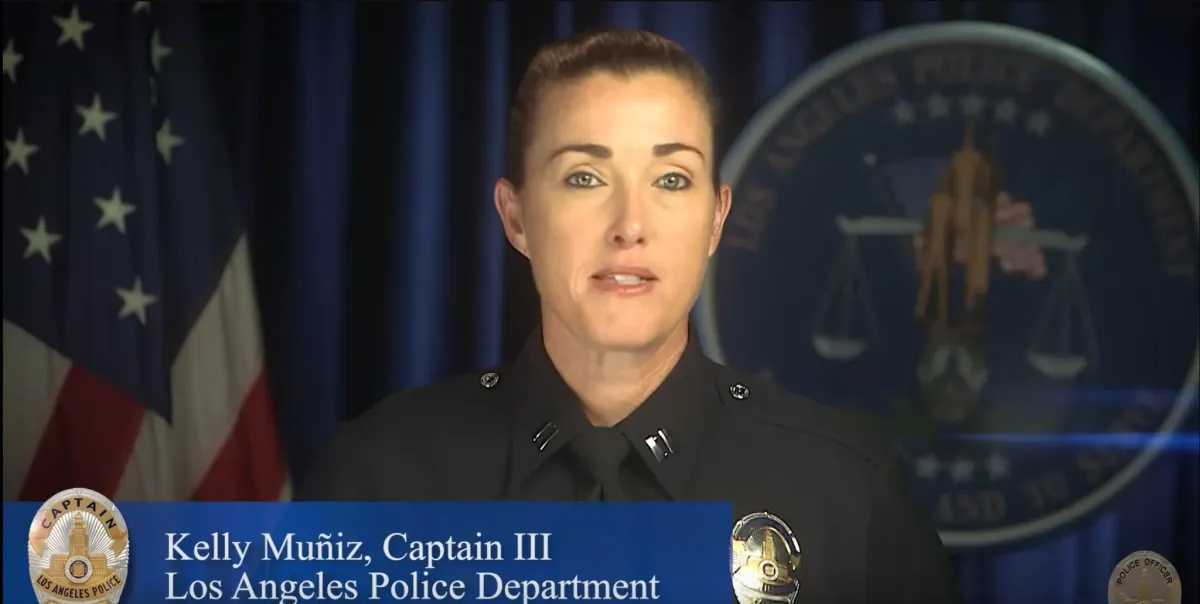
The lawsuit alleges the department is withholding footage of the June 3, 2020, shooting of Jermaine Welch and misrepresenting reality in critical incident videos.
Journalists Ben Camacho and Sahra Sulaiman have filed a lawsuit against the LAPD alleging defiance of the California Public Records Act by withholding body-worn camera footage of the June 3, 2020, shooting of Jermaine Welch. Welch was a bystander at the intersection of Broadway and 86th Place when LAPD opened fire into a crowd of people.
On the night of June 3, 2020, Jermaine Welch was making deliveries for Weedies when he drove up to a crowd of people at the intersection of Broadway and 86th Place. He heard someone shout “fuck cops” shortly before seeing a bright light and being hit by bullets. He was shot six times.
Jermaine had no idea who shot him but drove away with a bullet lodged in his lung, another in his abdomen, and another having damaged the hand he used to protect his face so badly that he came close to losing his fingers. When he woke up in a hospital bed, he was restrained. His doctors told him he had been placed in restraints because LAPD was treating him as a suspect in the shooting.
On July 24, 2020, Knock LA journalist Ben Camacho submitted a public records request to LAPD seeking the body-worn video (BWV) footage for any and all officers present at the June 3, 2020 shooting. The department has delayed the production of footage more than 10 times and now claims the videos won’t be available until “at least January 2024.”
Early on in the process, the department pointed to their critical incident video as sufficient disclosure in response to the public records request. Critical incident videos are videos put out by local law enforcement that summarize an incident when force is used, through the sharing of 911 calls, timelines, and in-car and on-person video footage, along with evidence collected. These professionally produced videos are how police departments comply with state law AB748, which requires the release of video after shootings and other use-of-force incidents in which police cause bodily harm within 45 days.
However, the video includes only one clip of the shooting itself. The clip begins approximately one second before the officer shoots their gun and leaves out the moments leading up to the shooting.
Every critical incident video put out by LAPD contains a video clip featuring the captain of LAPD’s Media Relations Division explaining that the body-worn video cameras automatically and continuously record a full two minutes of video prior to the moment of camera activation. This means there are two full minutes missing from the clip that was included in LAPD’s official critical incident video. The missing footage would reveal what the officers saw, what they were doing, and what led up to the officer shooting toward the crowd.
The LA Board of Police Commissioners’ report on the shooting also acknowledges that BWV footage from eight other officers exists. However, no videos from the other officers’ body-worn cameras are included in the critical incident video.
Shakeer Rahman, the lawyer representing the plaintiffs, says that the critical incident videos tell a story, but not the full story: “LAPD’s body-camera program is used entirely for surveillance and propaganda. As soon as LAPD kills someone, its multimillion-dollar PR department slices footage from the cop’s body camera into narrated videos that serve to mislead and confuse the public about what happened.”
The lawsuit, along with Sahra Sulaiman’s reporting on other incident videos, points to the ongoing problem of the department deliberately editing these videos to be misleading and incomplete.
In December 2021, Sahra Sulaiman reported on LAPD’s critical incident video of the shooting of 14-year-old Valentina Orellana Peralta in North Hollywood. When LAPD officer William Dorsey Jones Jr. shot Daniel Elena Lopez with an assault rifle inside a clothing store, one of the rounds went through the wall of the dressing room where Valentina was hiding and killed her. The critical incident video that was later released was edited to mislead the public, who were criticizing the department for killing Valentina, about the circumstances of the shooting.
Sulaiman says that the “moment that LAPD chooses to cut the security footage to another angle was deliberate and obscures the public’s ability to accurately understand the shooting.”
These stylized and edited videos are a part of a multimillion-dollar public relations operation. In 2020, the Los Angeles Times reported that LAPD was paying 25 people for public relations work, costing taxpayers almost $3.3 million a year, in order to publicize one-sided narratives about police shootings.
One private firm, Cole Pro Media, worked with at least 30 different police agencies across California in 2020 to produce critical incident videos that help shape the public’s knowledge of an incident through police narratives. Notably, Cole Pro Media is run by a former news anchor, Laura Cole, who approaches controversial incidents with scripts for police departments and teaches classes that show agencies “how to make reporters work for you” by “managing the mainstream media.” The style of videos Cole Pro Media has produced is nearly identical to the way LAPD crafts their videos.
The plaintiffs hope to receive all the footage from the June 3 shooting without further delay. Both plaintiffs lament the fact that it takes a lawsuit for the department to comply with the request to provide documentation and recordings they feel they are legally entitled to per California Public Records law. They hope that with the rest of the unedited footage, the public will have a better understanding of what actually happened the night of June 3 and that it will show that Jermaine Welch is a victim, not a suspect.
Ben Camacho is a writer for Knock LA covering issues related to policing in the city and county of Los Angeles.
